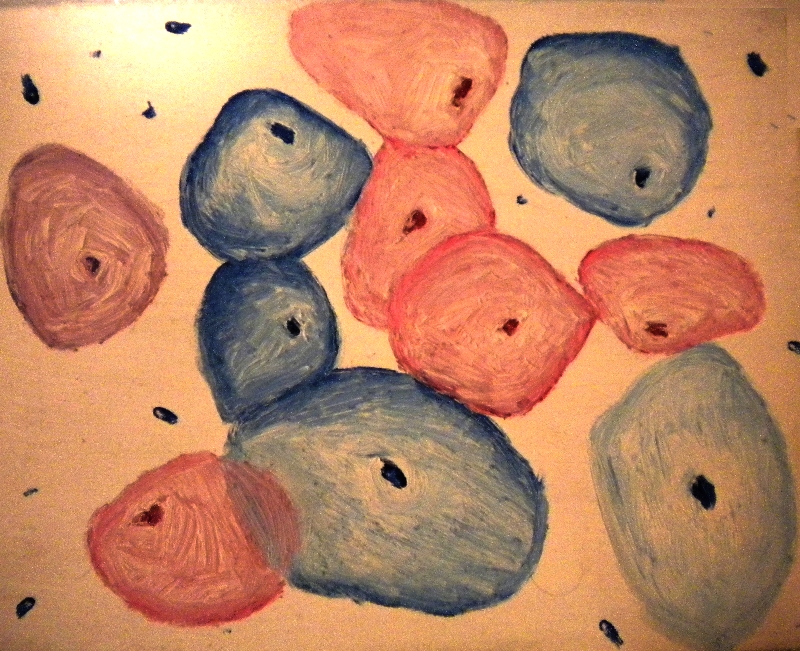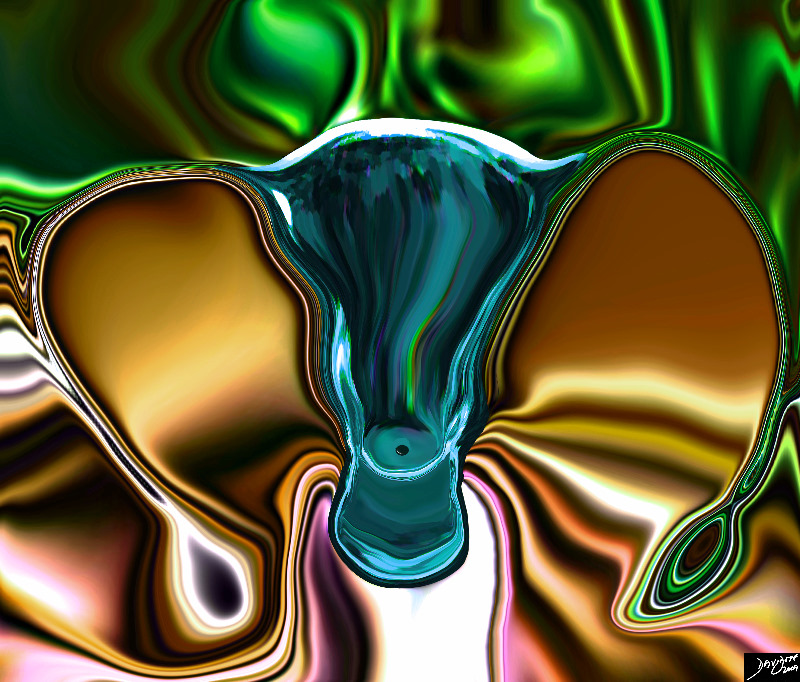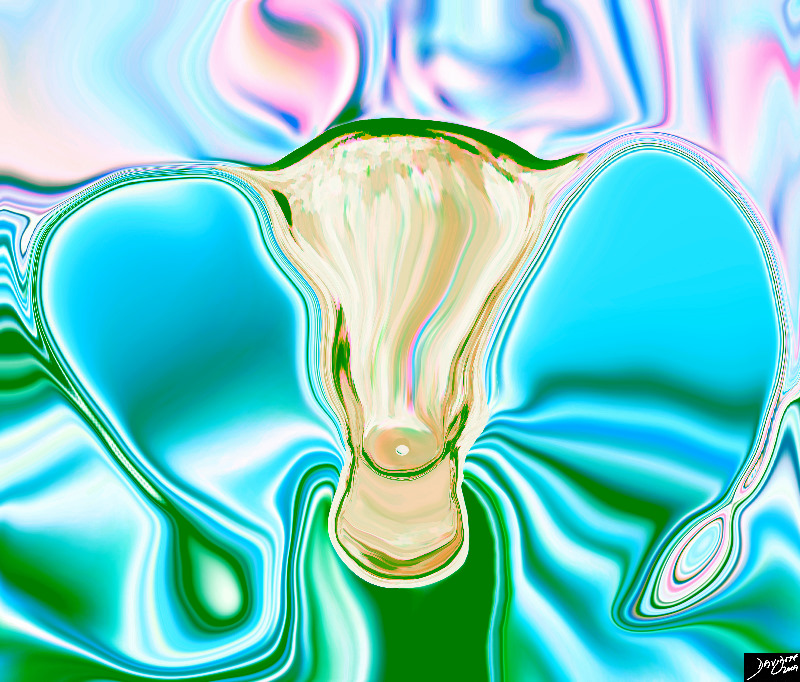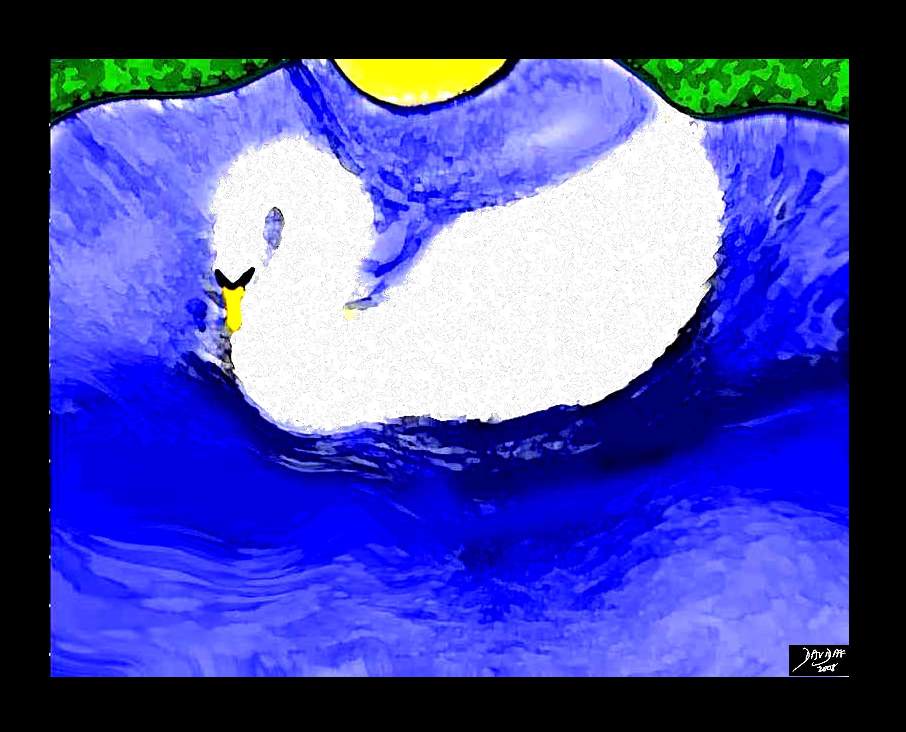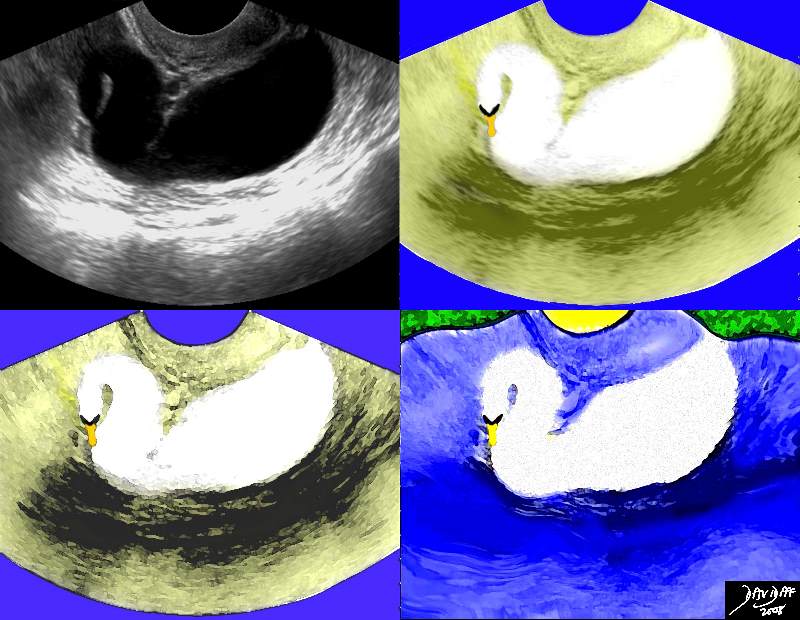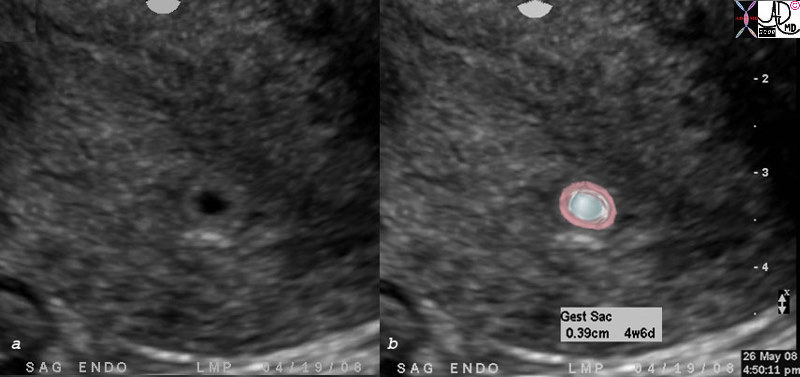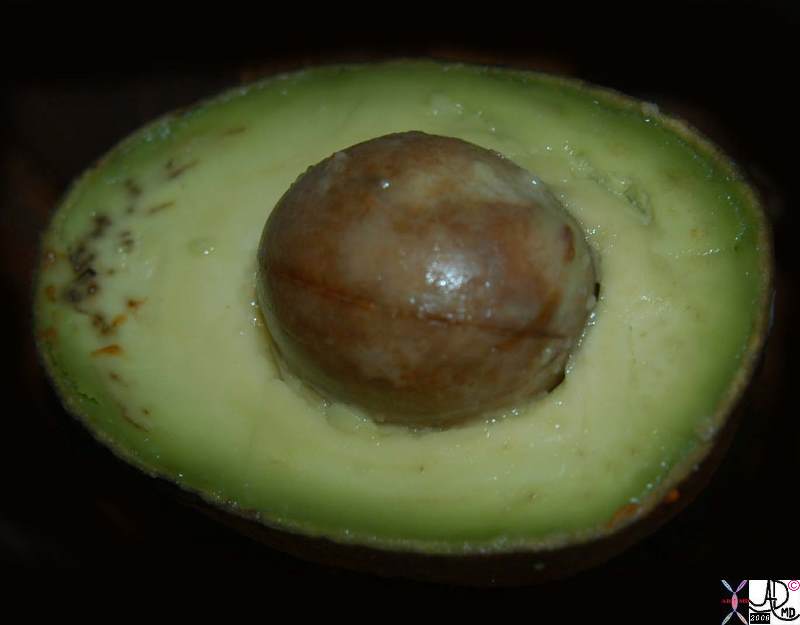Uterus
Copyright 2020
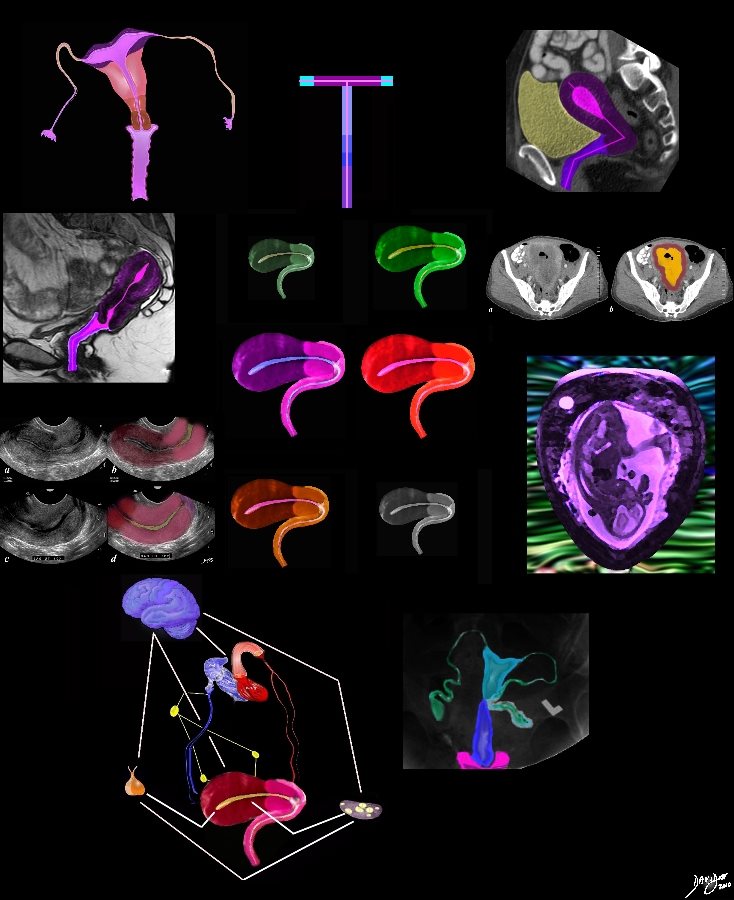
The collage of images reveals the multifaceted profile of the uterus in youth and old age and in health and disease
Courtesy Ashley Davidoff MD Copyright 2020 All rights reserved 96269.9s
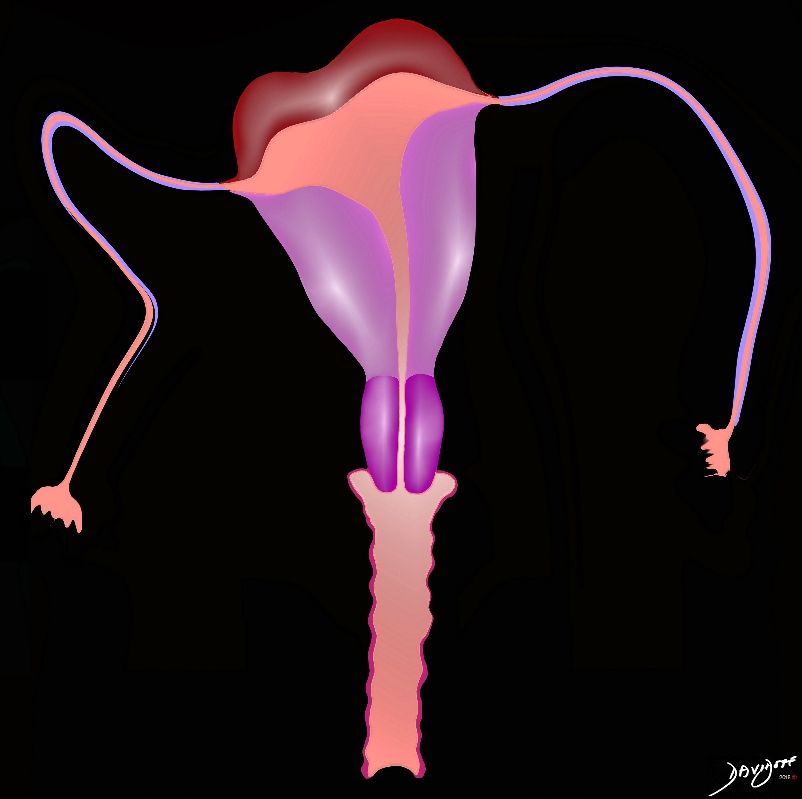
by Ashley Davidoff MD
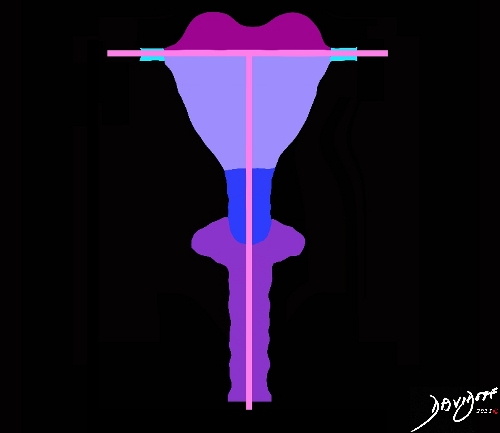
The uterus is built around a T – shaped scaffolding and the final product is triangular in shape. In this art piece the transverse superior aspect of the uterus (fundus) is supported by the horizontal bar of the T, and the vertical strut passes through the endometrial cavity, through the cervix and into the vagina. The shape of an IUD bears a similar shape and hence can fit snugly in the endometrial cavity.
by Ashley Davidoff MD
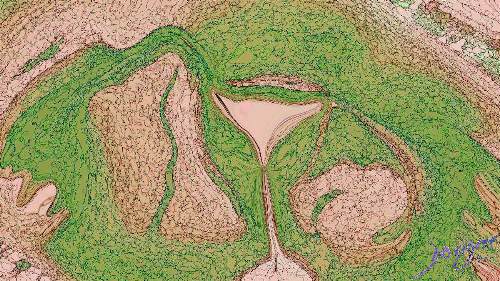
The symbolism of a turned down triangle has strong feminine implications ; female, mother, moon, yoni (Hindu divine mother) , shakti (female principle of divine energy) . The triangular shaped uterus, Fallopian tubes, broad ligaments and ovaries are projected in the earth colors of green and brown in this abstract art piece. The idea is to equate mother earth, and mother nature, and mothers.
by Ashley Davidoff MD

The uterus, is a hollow muscular organ that is part of the genitourinary system. It is characterized by its important role in the female reproductive system.
Structurally it is characterized by its pear shape and its unique muscular structure that undergoes profound changes during different reproductive events. Though it is a pelvic structure it enlarges many times over to become an intra abdominal organ during pregnancy and returns to its pre pregnancy state after child birth. Superiorly the gracile fallopian tubes open on each side into uterine cavity, and inferiorly it communicates with the vagina through the cervix. The urinary bladder lies anterior to it and rectum to posterior.
Functionally it provides a nutritional and protective environment for a fertilized embryo to embed, and accommodates a growing embryo until child birth.
Common diseases include alterations in the structure which can be congenital or acquired, benign or malignant tumors. Systemic disease especially infections can also affect uterus and uterine cavity.
Clinically the more common ailments manifest as infertility, menorrhagia, acute or chronic abdominal pain, urinary complaints, and recurrent abortions, .
Diagnosis is usually by detailed history and physical exams with imaging modalities like ultrasound, hysterosalpingography, hysteroscopy and diagnostic laparoscopy being most widely used.
Treatment options are guided by disease process and may include minimally invasive or open surgery.
by Ashley Davidoff MD

The sagittal reconstruction of a CT scans shows the uterus (yellow) with endometrium (green) a resting on the partially filled bladder (dark brown). The sacrum is seen posteriorly and small bowel anteriorly
Artistically the colors of the image portray a fall like mood.
by Ashley Davidoff MD
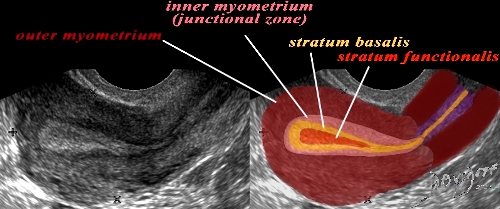
A transvaginal ultrasound of a premenstrual woman in the sagittal plane (left) reveals a normal view of the uterus with characteristic premenstrual appearance. Image on the right is an overlay showing the components of the endometrium and subendometrial layers. The stripe is almost homogeneously echogenic and thick but also shows a hypoechoic halo of the junctional zone or inner myometrium. (salmon) The homogeneous stripe is made up from two histological layers (barely distinguished by this ultrasound)– the inner stratum functionalis (deep orange) that will shed once the spiral arteries vasoconstrict, and the outer stratum basalis (deep yellow) that will not shed, and will be the basis for regenerating the endometrium in the next cycle. The next layer as stated above is the compact myometrium – the junctional zone (aka inner myometrium) , and is followed by the thicker outer myometrium (maroon).
The junctional zone is hypoechoic due to decreased water content, and is formed by smooth muscle cells that are tightly packed. The extracellular matrix and water content are sparse. It usually measures less than 8mm.
by Ashley Davidoff MD

A T 2 weighted MRI in the sagittal plane (left) reveals a normal e uterus with characteristic premenstrual appearance (left image). The image on the right is an overlay showing the endometrial cavity in yellow, then a light mauve color of the junctional zone or inner myometrium, and finally the outer myometrium (maroon).
The junctional zone is low intensity on T2 due to decreased water content, and is formed by smooth muscle cells that are tightly packed. The extracellular matrix and water content are sparse.
by Ashley Davidoff MD
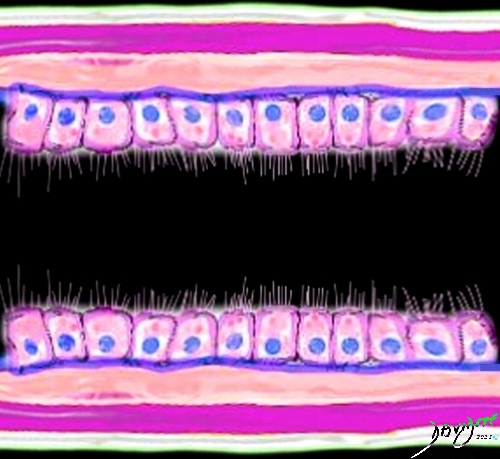
Cells of the Endometrium of the Uterus
The endometrium is lined by a ciliated epithelium which in turn form a simple tubular gland. The ciliated columnar cells rest on the basement membrane (deep blue) which in turn are embedded in a stroma (pink)
by Ashley Davidoff MD

This diagram exemplifies the position of the arteries in the epithelial and muscular layers of the uterus. The arcuate artery lies at the base of the image base within the myometrium. It gives rise to the radial artery that also courses through the myometrium. When the radial artery leaves the myometrium it becomes the straight artery that terminates in the spiral arteries. The spiral arteries run in the stratum functionalis, the straight arteries run in the stratum basalis, while the radial arteries and the arcuate arteries run in the muscularis.
by Ashley Davidoff MD
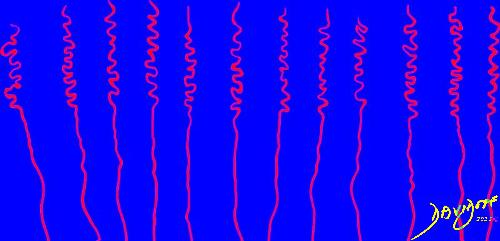
This diagram exemplifies the position of the arteries in the epithelium of the uterus. The straight arteries are so named because of their shape, and they lie in the mucosa, and terminate in the spiral arteries which are alo in the mucosa and so named because of their shape . The spiral arteries run in the stratum functionalis, the straight arteries run in the stratum basalis.
At the time of menstruation the spiral arteries and the stratum functionalis ar shed
Artistically the straight arteries and and spiral arteries are personified to look like people. The blue background creates the effect of a blue sky on a summer day, and hence the name -“taking a walk on a summer day”.
by Ashley Davidoff MD
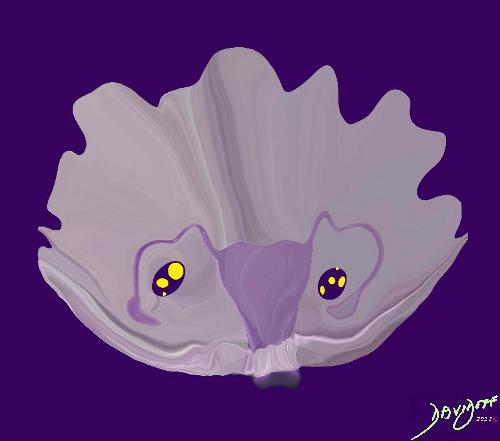
The uterus is draped in peritoneum but invaginates it’s body into the centre of the pelvis just like the central portion of the flower which contains the pistil (stigma, style and ovary) and stamen (anthers and filaments). The peritoneal cavity or coelomic cavity is a large cell lined space via which almost all the abdominal organs are connected . It may be considered the suburban space around which the houses of the town are positioned. The ova are released from the ovary into the space, but they are quickly directed by the fimbriae into the Fallopian tubes.
by Ashley Davidoff MD

The uterus is draped in peritoneum but invaginates it’s body into the centre of the pelvis just like the central portion of the flower which contains the pistil (stigma, style and ovary) and stamen (anthers and filaments). The peritoneal cavity or coelomic cavity is a large cell lined space via which almost all the abdominal organs are connected . It may be considered the suburban space around which the houses of the town are positioned. The ova are released from the ovary into the space, but they are quickly directed by the fimbriae into the Fallopian tubes.
by Ashley Davidoff MD
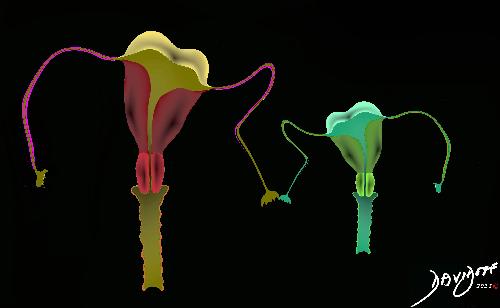
This art piece shows a mother uterus (left) with fundus, body and lower uterine segment, cervix,endometrial cavity, vagina with Fallopian tubes and fimbriae holding hands with her daughter and taking a walk. Their heads are tilted toward each other in affection and they have a happy demeanor.
by Ashley Davidoff MD
Size
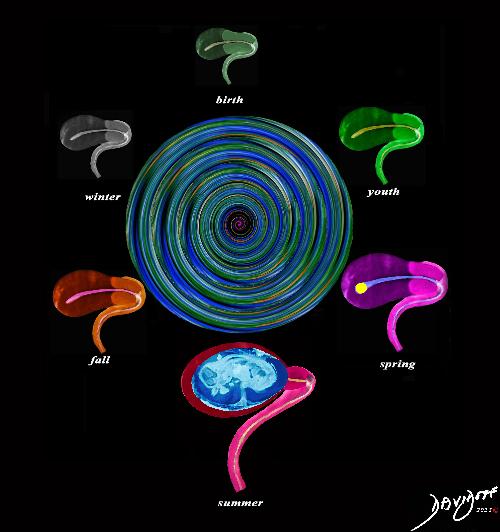
“Life Cycle of the Uterus” shows the uterus from birth through maturation to senility
by Ashley Davidoff MD
Shape
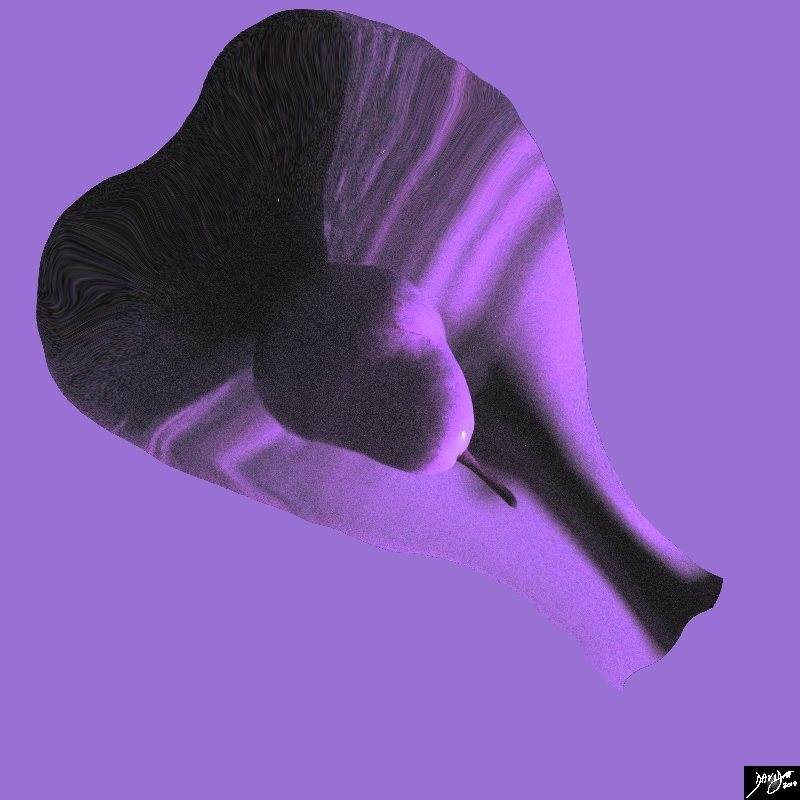
The uterus is shaped like a pear
Courtesy Ashley Davidoff MD Copyright 2010 All rights reserved 85370pd07b.8
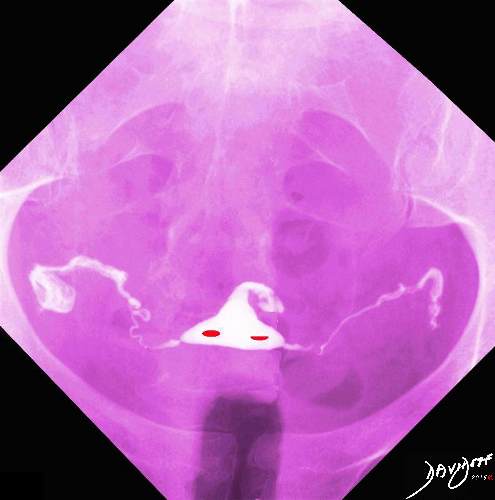
The art piece shows the enhancement of a hysterosalpingogram. The colors and body language speak to a romantic situation, with an encouraging wink from the uterus to her suitor
by Ashley Davidoff MD
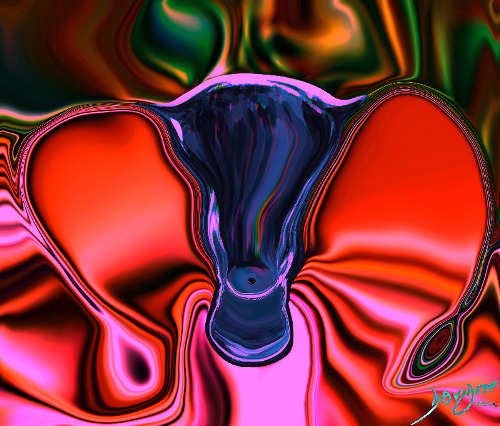
The art piece shows the uterus with other members of the gynecological team including the fornix of the vagina, cervix, Fallopian tubes, and ovaries all clothed in the red cloak of the broad ligament. The darkness of the uterus provides a mysterious ambience, while the red cloak of the broad ligament brings passion of toreador fame.
by Ashley Davidoff MD
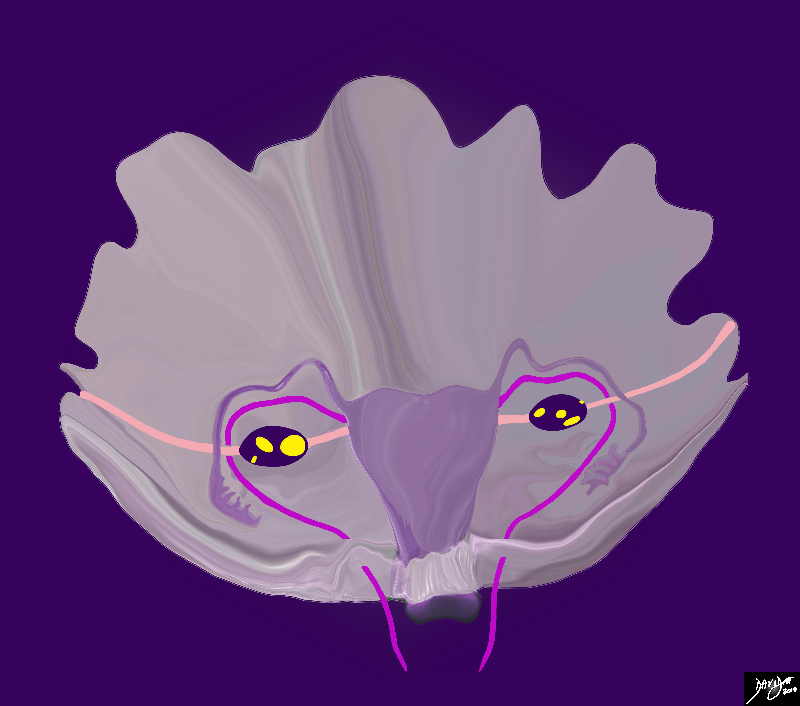
This diagram (behind the scenes and behind the peritoneal covering) illustrates 3 cord like structures that are found near the cornu of the uterus including; the Fallopian tubes (light mauve) the round ligament of the uterus (bright pink) and the ligament of the ovary (light pink) The distal end of the Fallopian tubes end in the fimbriae, while the distal end of the round ligaments enter the inguinal canal. On the other side of the ovary the the ligament of the ovary is called the suspensory ligament of the ovary, aka infundibulopelvic ligament (commonly abbreviated IP ligament or simply IP) and it ends by attaching to the lateral wall of the pelvis. c
Courtesy Ashley Davidoff MD Copyright 2010 All rights reserved 04766b05b04.52kd17a09.8s
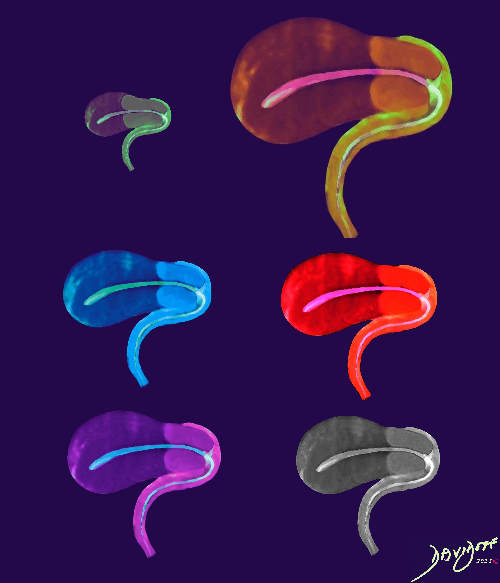
The uterus is projected in different colors and sizes that reflect her moods. The small uterus for example projects a lack of confidence while the large uterus represents an overconfidence. Blue for example could portray a calm mood, or a cold mood. The pinks and purples may reflect a feeling of femininity.
by Ashley Davidoff MD
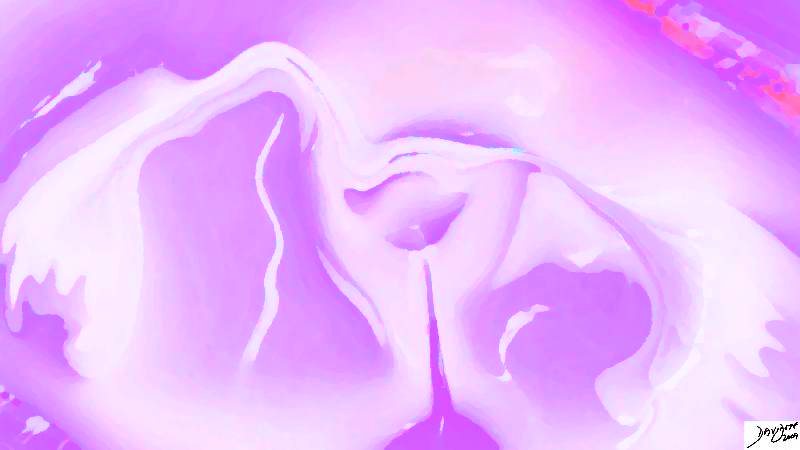
Davidoff art copyright 2020 all rights reserved
93639pb05b01.8s

This collage of the uterus describes the life and times of the uterus; From menstrual cycles, partying, dancing, retroversion, introversion, anteversion, resting, protesting, men, fertilization, pregnancy, birth labor, to disease
by Ashley Davidoff MD

The art piece shows the arteries supplying the uterus, ovaries, Fallopian tubes and vagina. Arterial supply is via the internal iliac, external iliac arteries and the aorta.
by Ashley Davidoff MD
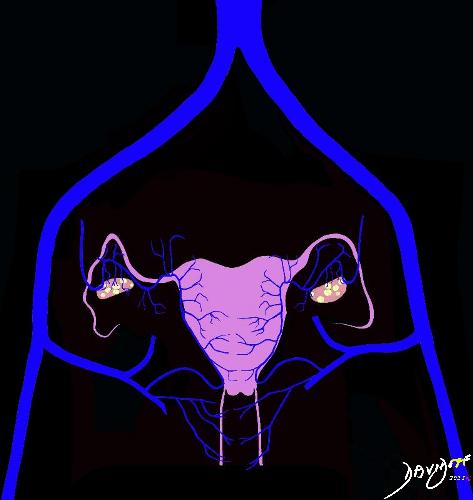
The art piece shows the venous drainage of the uterus. Drainage is via the internal iliac, external iliac veins and then to the inferior vena cava.
by Ashley Davidoff MD
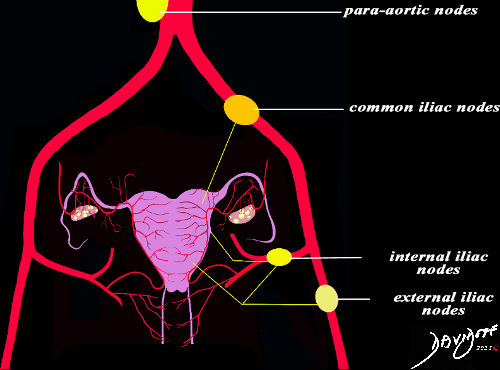
The art piece shows the lymphatic drainage of the uterus. Drainage is via the internal iliac nodes, external iliac and para-aortic systems
by Ashley Davidoff MD
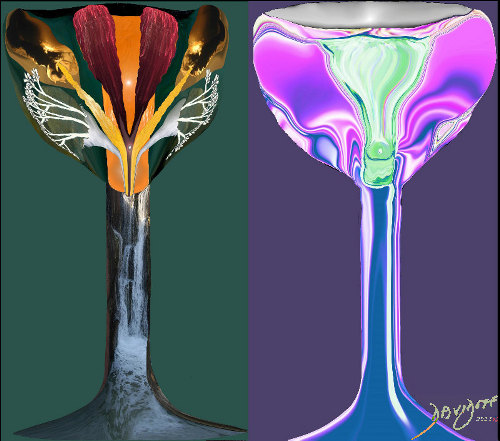
The uterus and prostate are out on a date and sharing a cocktail The uterus approximates a rectangular shape as does the prostate accounting for their fascination with each other and having similarity with the shape of the wine glass. The uterus is accompanied by the ovaries and the vagina which forms the stem of the wine glass. The prostate is accompanied by the Seminal vesicles and Cowper’s glands and the urethra which acts as the stem of the wine glass. The male secretion seen in the urethra consists of a mixture of sperm, prostatic secretions, and seminal vesicle secretions.
by Ashley Davidoff MD
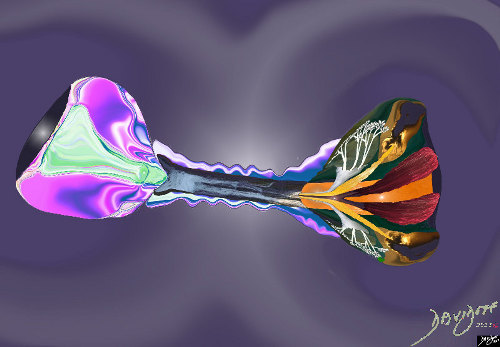
The uterus and prostate bonding in ecstasy is about all the sex organs getting together in the reproductive act. The male juices (right side of the rendition) consist of a mixture of sperm, prostatic secretions, and seminal vesicle secretions. The female system directs the ejaculate to the cervical opening. Her secretions help protect and nourish the sperm before they proceed on the journey and race to ovum in waiting.
by Ashley Davidoff MD
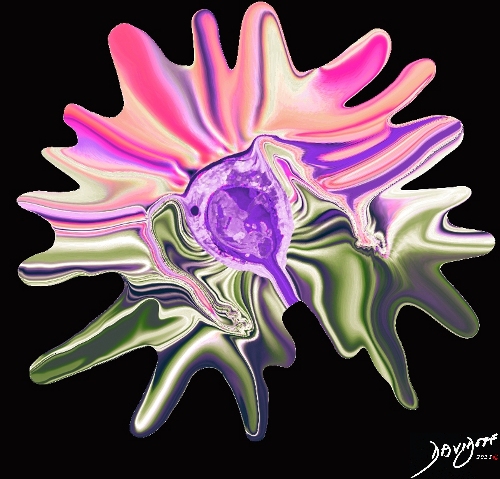
The art piece demonstrates the gravid uterus in the centre of the colorful petals of the flower. Much like the anatomy of a flower in which the reproductive organs are centrally placed, the art piece shows the human reproductive organ reflecting the anatomic position of the pistil (stigma, style and ovary) and stamen (anthers and filaments). The petals in this instance represent the peritoneal cavity or coelomic cavity which is a large cell lined space via which almost all the abdominal organs are connected.
by Ashley Davidoff MD
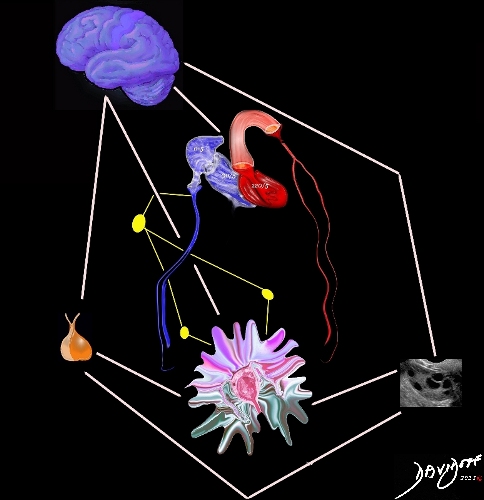
The art piece demonstrates a few of the organs that contribute to the maintenance and growth of a pregnancy. The gravid uterus is shown in the centre of the colorful petals of the flower. It is surrounded by the physiological contributions of the nervous system represented by the brain, endocrine system represented by the pituitary gland and ovary, and the cardiovascular system represented by the heart arteries and veins.
by Ashley Davidoff MD

“Embryonic Homo Sapiens Baby and the Earth” explores surrealism and spherism . It portrays an intrauterine pregnancy in the womb of mother earth. The earth is floating in orbit surrounded by the sky, clouds, sun, and mountains. The tenets of space, environment, and time are inferred and are elemental in the evolution that created the miracle of our species.
by Ashley Davidoff MD
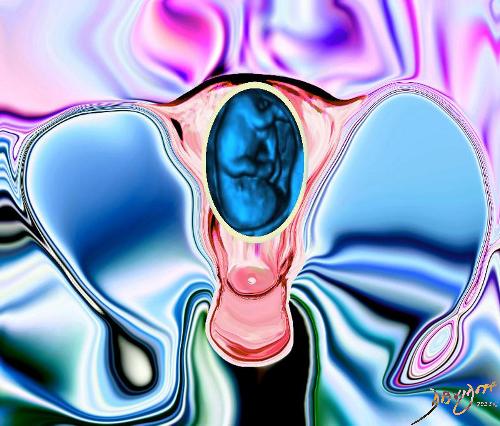
The art piece shows the uterus with a 3D reconstruction of an ultrasound of a fetus resting in the warmth of the womb. The red of the uterus provides the warmth, the blue of the amniotic fluid and broad ligament provides calm, and the Fallopian tubes provide tender loving “arms”.
by Ashley Davidoff MD
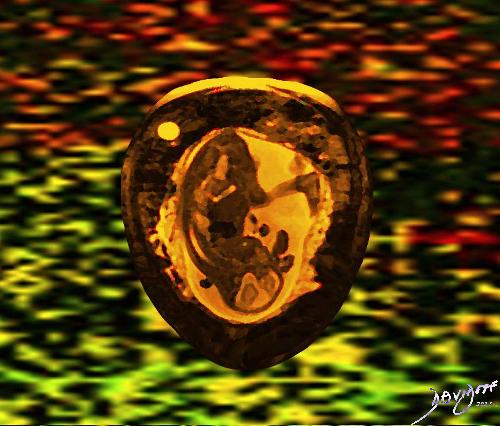
“An Autumn Beginning for this Baby” shows an MRI of a pregnant uterus in the third trimester. For this baby the fall is a beginning
by Ashley Davidoff MD
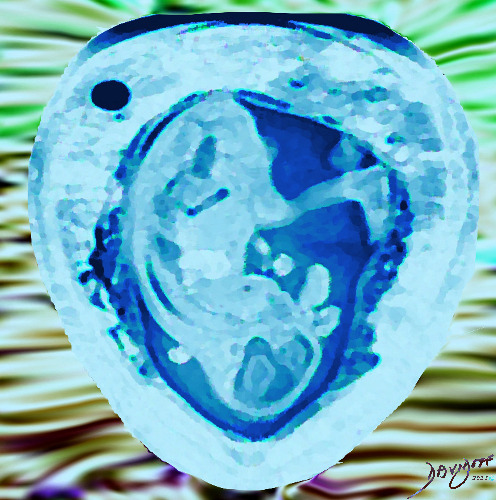
The AiA derivation from an MRI of the pelvis of a pregnant woman shows a fetus in vertex position. The head, chest, abdomen, and lower limbs are seen in a sagittal projection. The background of blues, greens, and browns reflect the nourishing environment and support that the developing fetus receives from the mother.
by Ashley Davidoff MD
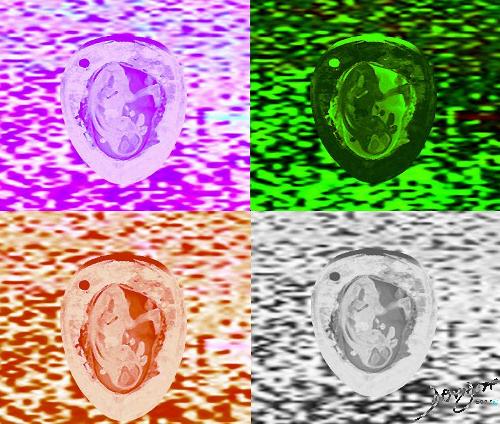
The MRI of the gravid uterus shows pregnancy in the colors of the seasons. The pink represents the spring time, the green the summer, the brown the fall, and the white and black the winter. Life is a continual cycle and pregnancy goes through these same phases and cycles, of youth, through adulthood, until a new cycle, advanced in time starts. The art piece has anatomical, physiological, and philosophical elements.
Description
by Ashley Davidoff MD
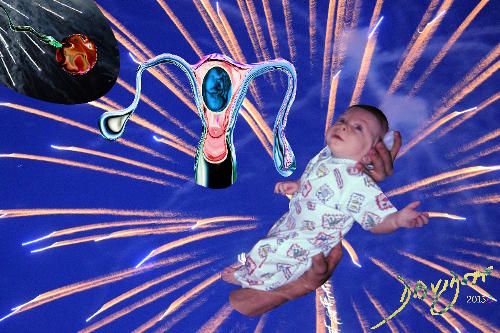
“Uterus; receive process produce export “ shows the basic process involved in the development of a baby from conception to birth
The uterus receives a fertilized ovum, and provides the environment for replication and miraculous growth and development to a fetus and then a baby The last phase is delivery or export into the world.
The style provides a chronological evolution of the physiological process.
by Ashley Davidoff MD
Diseases

A T 2 weighted MRI in the sagittal plane (left) reveals a uterus with a junctional zone that measures 13mm characteristic of adenomyosis. The image on the right is an overlay showing the endometrial cavity in yellow, then a light maroon color of the abnormally thickened junctional zone or inner myometrium, and finally the normal outer myometrium (maroon).
The junctional zone is low intensity on T2 due to decreased water content, and is formed by smooth muscle cells that are tightly packed. The extracellular matrix and water content are sparse.
by Ashley Davidoff MD
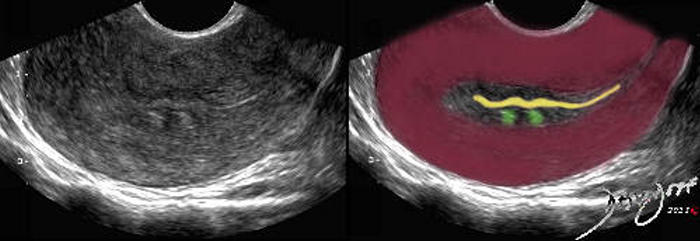
Two echogenic nodules (overlaid in green in image on the right) are present in the subendometrial layer, (junctional zone) of the uterus in a woman with menorrhagia. The nodules are in close proximity and have appositional relationships with the endometrial stripe (yellow overlay). They distort the endometrial lining. These findings likely account for the menorrhagia. Included in the differential diagnosis are dystrophic changes in prior foci of adenomyosis and submucosal fibroids. An MRI would assist to characterize the lesions in the subendometrial layer.
The junctional zone is hypoechoic due to decreased water content, and is formed by smooth muscle cells that are tightly packed. The extracellular matrix and water content are sparse. It usually measures less than 8mm. In this case the thickness is normal.
by Ashley Davidoff MD
d
|
Normal PAP smear |
|
Normal PAP smear Courtesy Laura Miller MD 96933B.8 |
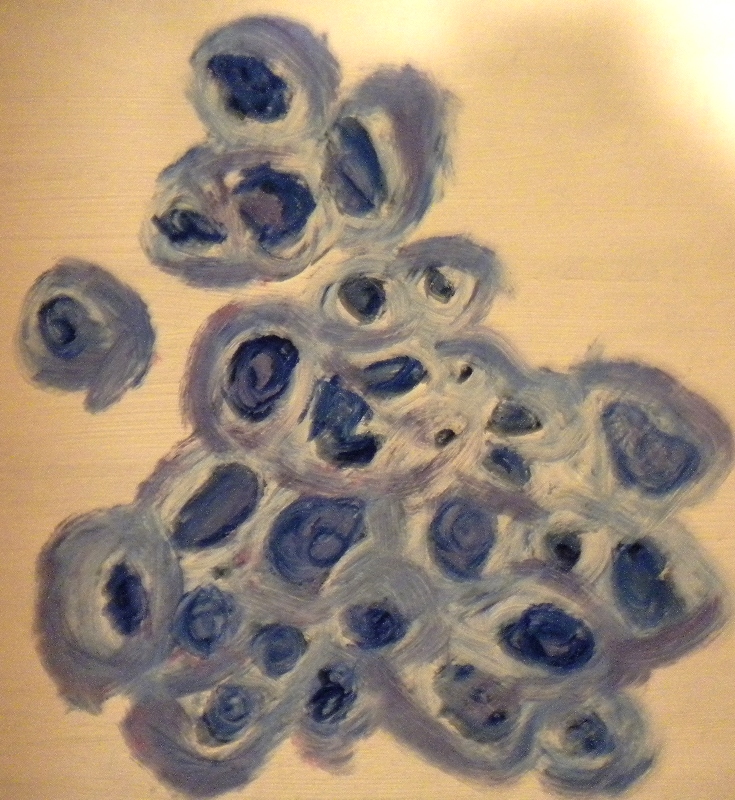
Abnormal PAP Smear – Cervical Carcinoma |
|
Abnormal PAP smear Cervical Carcinoma 96933B.8 Courtesy Laura Miller MD 96934b.8 |
|
Normal Uterus, Cervix, Fallopian Tubes and Ovary |
| 46701b03.54k.8s uterus fallopian tubes cervix ovaries broad ligament normal anatomy vagina gravid vertex presentation brain placenta foot rawMRI T2 weighted Courtesy Ashley Davidoff MD Davidoff art copyright 2009 all rights reserved |
|
Normal Uterus, Cervix, Fallopian Tubes and Ovary |
| 46701b03.55k.8s uterus fallopian tubes cervix ovaries broad ligament normal anatomy vagina gravid vertex presentation brain placenta foot rawMRI T2 weighted Courtesy Ashley Davidoff MD Davidoff art copyright 2009 all rights reserved |
|
Swan Lake |
| 83334b01.21.8s uterus fallopian tube hydrosalpinx ultrasound Swan in the water Davidoff Art Courtesy Julie Copyright 2009 |
|
Swan Lake |
| 83334c03.8s uterus fallopian tube hydrosalpinx ultrasound Swan in the water Davidoff Art Courtesy Julie Copyright 2009 |
|
Early IUP |
| 78403c02.8 baby pregnancy OB fetus gestational sac 4 weeks and 6 days early IUP OB endometrium no fetal pole uterus endometrium normal Courtesy Ashley DAvidoff MD |
|
Avocado and the Uterus |
| 87836pb01.8s uterus food in the body green shape cholesterol Avocados, Eggplant and Pears relate to structure (similar shape) function of the womb and cervix of the female – one avocado a week, it balances hormones, prevents cervical cancers. It takes between 6 and 12 months to grow an avocado from blossom to ripened fruit. There are over 14,000 photolytic chemical constituents of nutrition in each one of these foods (modern science has only studied and named about 141 of them). Davidoff Photography Copyright 2008 |
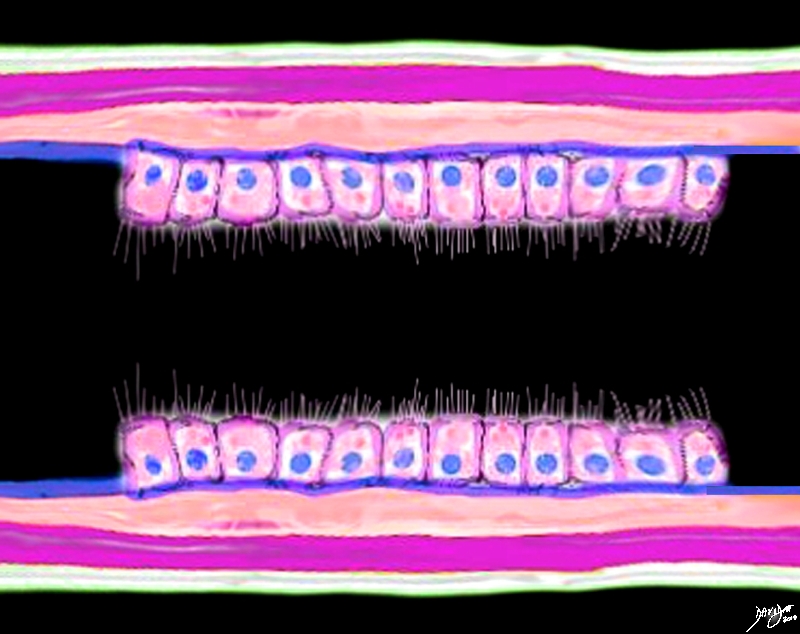
Histology of the Endometrium |
|
The diagram typifies the histological appearance of the endometrium which follows the basic 3 component pattern of tubular systems in the body; mucosa – ciliated columnar cells, basement membrane (blue) and submucosa (orange) muscularis – (pink) and serosa (cream). Courtesy Ashley Davidoff MD Copyright 2010 All rights reserved 32347e03b01.8s |
